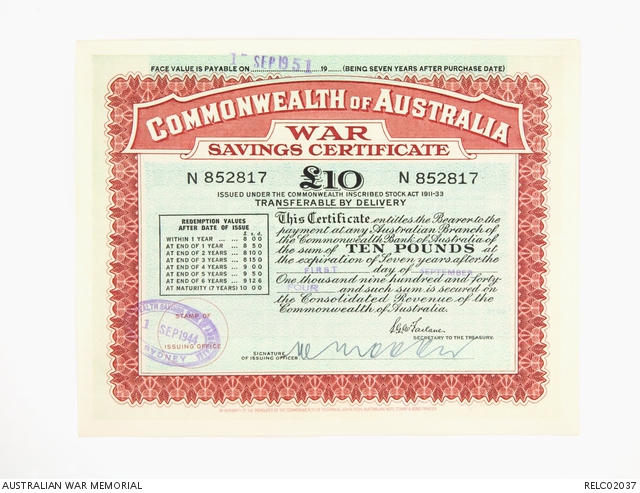| Places | |
|---|---|
| Accession Number | RELC02037 |
| Collection type | Technology |
| Object type | Currency |
| Physical description | Paper |
| Maker |
Ash, John |
| Place made | Australia, Australia: New South Wales, Sydney |
| Date made | 1 September 1944 |
| Conflict |
Second World War, 1939-1945 |
Commonwealth of Australia War Savings Certificate 10 pounds


Rust and aqua Commonwealth of Australia-issued War Saving Certificate of ten pounds face value. The face is printed with the details and conditions of issue, giving the purchaser a return of five pounds over seven years for an initial investment of eight pounds. The expiration date (1 SEP 1951) has been stamped in the appropriate space at the top of the certificate in purple ink, while the original issue date ("FIRST day of SEPTEMBER 1944") is also stamped in the same manner. The certificate is signed, and has been stamped with the identification of the Commonwealth Savings Bank of Australia, Sydney, with the date. The note's individual serial number, N852817, appears twice on the face, either side of the denomination. The reverse is printed with details allowing redemption of the certificate "at any time".
Individual history is unknown.
This ten pound War Savings Certificate is part of a series issued by the Commonwealth of Australia between 1940 and 1945, in £1, £2, £5, £10 and £50 certificates. The aim of the issue was to raise public funds for the financing of the war, by placing public savings at the disposal of the government. Essentially, the public were lending the government money for seven years.
The Australian Government realised that funding this war, fought across the globe against multiple enemies using weapons and technology far more advanced than that used in the First World War would prove very costly. The Federal Budget grew from £170 million in the financial year 1940-41 to £308 million in 1941-42, to £537 million in 1942-43, and as the war grew in scope the costs kept ballooning. The war ended up costing the Australian economy over £2 billion, (the equivalent of $14 billion today) and more than eight times than the cost of the war of 1914-18. It would need help from any sources it could find.
The idea of War Saving Certificates originated during the First World War (with the British Government), and the idea was revived in the Second. Certificates were first issued in May 1940, after the Commonwealth Bank of Australia organised for the design and printing, but ran into problems with the supply of the bond paper it was printed on, and after June 1940, supplies were instead printed on banknote paper.
The public could buy any value of War Saving Certificates (technically up to the value of £250, but this was never properly controlled) at a purchase price less than the face value of the certificates – usually at an equivalent rate of 4/5 of the face value. So a £10 certificate would sell at £8 but be redeemable for £10. At the end of seven years customers could redeem the certificate for the face value, or they could opt for bowing out of the scheme any time for the face value of the certificate. It is surprising how many War Savings Certificates remain in people’s collections, never redeemed, even though there was a date stamp on the top of the certificate indicating the date when the certificate was due.
Each certificate was issued with a serial (usually one or two letters followed by number, up to 6 digits) while the different values of the certificates were denoted by different colours. Certificates could not only be purchased at Commonwealth Banks (where the management had to extend opening hours and put on extra staff to cope with the demand), but were also easily available from Victory Fairs, department stores, post offices and public rallies. Even in New Guinea at base depots, servicemen were encouraged to invest in Loans and Certificates.
In 1943, the average weekly wage for men was around £6 - the equivalent of about $600 in 2021. This combined with increased taxes - tax revenue increased from 16% to 44% between 1939 and 1942 - and rationing meant that Australians were doing it tough. Despite this, the government borrowed (according to the Commonwealth Bank’s website) £1.16 billion over five years contributed from over 3.8 million applications from the public.
The need for War Bonds and Savings Certificates was relentlessly pursued by the government from mid-1940. Posters, captured enemy planes and tanks, examples of Australian war production, the Lancaster G for George, weekly radio talks, demonstrations and parades of service people; all were used to sell the government’s message. And it wasn’t only war certificates – there were Victory Loans, Austerity Loans, Liberty Loans and War Bonds as well as savings stamps and tally boards recording each suburb’s contribution. Despite the invasion threat being over by mid 1943, the Government concealed this for a further two years – everyone was encouraged to contribute until 1945. There was no getting away from it.
It was an expensive time for Australians.